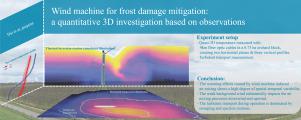Agricultural and Forest Meteorology ( IF 5.6 ) Pub Date : 2023-05-31 , DOI: 10.1016/j.agrformet.2023.109522 Yi Dai , Judith Boekee , Bart Schilperoort , Marie-Claire ten Veldhuis , Bas J.H. van de Wiel

|
Wind machines have been increasingly used for frost damage mitigation in the agricultural community. During radiative frost nights, wind machines are used to erode near-surface thermal inversion by air mixing. The underlying mixing processes remain poorly understood. A full picture of warming effects caused by air mixing requires measurements with wide coverage and high resolution. Our study aimed to quantify the magnitude and area of warming by air mixing and identify the characteristic mixing processes downwind and upwind. We installed 9 km of fiber optic cables in a 6.75 ha orchard block, creating two horizontal planes and three vertical profiles. Quasi-3D temperature responses with spatial sampling and temporal resolution of 25 cm and 10 s, respectively, were obtained before and during machine operation. We found a 50% reduction of the local inversion strength (8 K) over 0.42 ha at 1 m and 0.46 ha at 2 m height. The warming area for a 30% reduction extends to 2.81 and 2.52 ha, respectively. As the propeller rotates 360°, the weak background wind substantially impacts the air mixing processes downwind and upwind. When jets blow along with background wind, the warming plumes arrive earlier than the jet due to horizontal advection from earlier warmed sections. The warming plumes consequently accumulate downwind and penetrate deep into the canopy. In contrast, in upwind direction, wind drag resistance causes warming plumes arrive later than the jet. Quadrant analysis reveals that flux transport during the machine operation is dominated by sweeping and ejection motions. Intermittent downdrafts of warm air and updrafts of cool air result in efficient vertical heat exchange. This feature makes wind machines highly effective in raising canopy airspace temperature to mitigate frost damage.
中文翻译:

用于减轻霜害的风力机:基于观察的定量 3D 调查
风力机越来越多地用于减轻农业社区的霜害。在辐射霜夜期间,风力机用于通过空气混合来侵蚀近地表的逆温。潜在的混合过程仍然知之甚少。要全面了解空气混合造成的变暖效应,需要进行大范围和高分辨率的测量。我们的研究旨在量化空气混合引起的变暖幅度和面积,并确定顺风和上风的特征混合过程。我们在 6.75 公顷的果园地块中安装了 9 公里的光缆,形成了两个水平面和三个垂直剖面。在机器运行之前和期间获得空间采样和时间分辨率分别为 25 厘米和 10 秒的准三维温度响应。我们发现局部反转强度 (8 K) 在 1 m 处的 0.42 ha 和 2 m 高度处的 0.46 ha 上降低了 50%。减少 30% 的增温面积分别扩大到 2.81 和 2.52 公顷。由于螺旋桨旋转 360°,微弱的背景风极大地影响了顺风和逆风的空气混合过程。当喷流与背景风一起吹动时,由于早期变暖部分的水平平流,变暖的羽流比喷流更早到达。因此,变暖的羽流顺风聚集并深入树冠。相反,在逆风方向,风阻导致变暖羽流比射流晚到达。象限分析表明,机器运行期间的通量传输主要由扫动和喷射运动控制。热空气的间歇性下降气流和冷空气的上升气流导致有效的垂直热交换。此功能使风力机在提高树冠空域温度以减轻霜冻破坏方面非常有效。











































 京公网安备 11010802027423号
京公网安备 11010802027423号